
Reading Notes for:
Pitch Anything
By Oren Klaff
An Innovative Method for Presenting, Persuading, and Winning the Deal
Learning to harness and understand the power of frames is the most important thing you will ever learn.
The winning frame governs a social interaction.
No situation has any real meaning until you frame it. The Frame sets the meaning. And there can only be 1 dominant frame. When you are reacting to the other person, they control the frame.
Analyst Frame: There is a rational explanation for this
Moral Authority Frame: You know this isn’t right. Played right, is almost impervious.
· “your words have no meaning. Stop talking.” “Listen Jim, stop that. Here is what you need to do….”
o Something good has to happen according to MY schedule
· For when Rational Arguments don’t work.
· Author called a lawyer on speaker about getting the FBI involved. “Let me paint the picture. A whole bunch of Agents show up and come storming out of cars…….”
Moment of first contact= that moment where the 2 frames come into contact. You can feel it in the pit of your stomach. Must commit completely to your frame and go full force and stick to your frame. PLOW forward.
Time Frames: Generally tend to happen later in the game, after someone has already established frame control. Use it to challenge your frame, to try to regain control. Audience might be a little bored. So pitch needs to stay exciting.
· “We need to wrap this up” is an attempt at frame control.
· Attention is an extremely rare phenomenon.
· Them: Yeah, we only have about 10 minutes but come on in. You: Ok, sure, let me get started. This is wrong! Don’t do this. You are reinforcing their status.
o Break it with a stronger frame of your own: 10 minutes? No, I don’t work like that. We can reschedule this. Though we need to figure out if this is worth our while. Like, do we like each other? Can we work together? And honor each other’s time and appointments.
Analyst Frame: generally comes after the initial frame collision. Will generally appear close to the time when a decision is due.
· Only values hard data and not relationships. Says that the non-analytical or people or relationship values of your deal have no value.
· Everyone in the room suddenly does a deep dive into the details. Common with engineers and financial analysts. When they are driving into the deep details will cool mood. Gets people lost in the neocortex. Cold cognitions- crunching numbers.
o Can’t have hot and cold cognition at the same time. Hot cognitions= excitement and interest. Separate the technical details separately.
· Have summary data available. Go over it quickly then bridge back to the big picture. “The details are X,Y, and Z. But first we need to figure out if this relationship works. If we can help each other.”
· When body language says they aren’t really interested anymore. Need to keep it interesting and novel.
· When you start a meeting, there is a natural tendency of people in the meeting to ask themselves “is this the same as- or similar enough to- something that I’m already familiar with or have solved, so I don’t have to pay attention?” Once they realize they were right, they will check out. Once they think they have ‘solved the puzzle’. They have decided they have learned all that they need to know about this.
· Intrigue Frame: busts intrigue frame.
Intrigue Frame: Most powerful because it triggers the more primitive part of the brain. Narrative and Cold Cognition cannot exist at the same time. Won’t happen. We cannot be warmly engaged in a story and analytical at the same time. Break it by telling an interesting story that involves you. Don’t make it up. Have it built and in the can. Build massive intrigue and have it centered around you. To bring attention back to you. But, only tell part of the story. Don’t tell them how it ends until you are ready.
· Should contain: 1. Brief and relevant, 2. you need to be in the center of it, 3. There should be risk danger and uncertainty, 4. time pressure somewhere and ominous consequences if it’s not handled quickly. 5. Should be tension. You are trying to do something but you are being blocked by someone or something, 6. Failure will not be pretty.
· The importance is WHEN to use it. When they are coming with the analyst frame.
· Can stop the analyst frame cold.
· The move Jaws: if you knew the size and where the shark was at all time, there isn’t any suspense.
